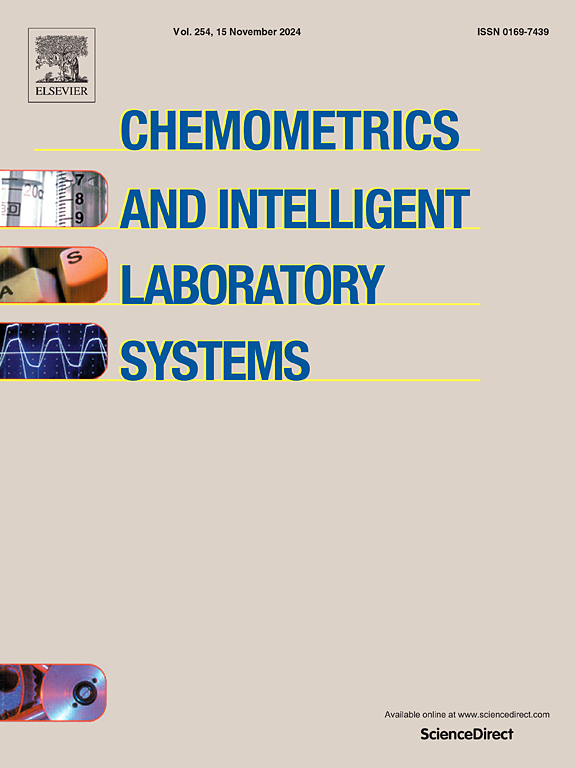基于Mix-Kernel支持向量机的H5N1型奥司他韦衍生物抗病毒效果QSAR模型研究
IF 3.7
2区 化学
Q2 AUTOMATION & CONTROL SYSTEMS
Chemometrics and Intelligent Laboratory Systems
Pub Date : 2024-11-13
DOI:10.1016/j.chemolab.2024.105273
引用次数: 0
摘要
为了帮助设计和合成新型奥司他韦衍生物,从而以更低的时间和成本获得更多的抑制剂,研究人员采用随机森林(RF)、极梯度提升(XGBoost)、径向基核函数支持向量机(RBF-SVM)和混合核函数支持向量机(MIX-SVM)等方法,建立了 83 个 ODs 的四个定量结构-活性关系(QSAR)模型。在研究中,射频识别出了五个最重要的描述符。为了进一步检验这四个模型的鲁棒性和稳定性,对模型进行了留空交叉验证,并使用 R、Rw 来衡量性能。由 MIX-SVM 建立的模型在数据集上表现最佳:训练集和测试集上的 R2 分别为 0.963 和 0.961,训练集和测试集上的均方误差(MSE)分别为 0.055 和 0.054,R、R 分别为 0.918 和 0.889。此外,还选择了五个重要的描述因子进行分析,应用 MIX-SVM 的建模方法取得了很好的预测效果,有助于奥司他韦衍生物的设计和合成。本文章由计算机程序翻译,如有差异,请以英文原文为准。

Studies on QSAR models for the anti-virus effect of oseltamivir derivatives targeting H5N1 based on Mix-Kernel support vector machine
To assist in design and synthesis of novel oseltamivir derivatives as to help yield more inhibitors with lower time and cost, four quantitative structure-activity relationship (QSAR) models on 83 ODs with methods of random forest (RF), extreme gradient boosting (XGBoost), radial basis kernel function support vector machine (RBF-SVM) and mix kernel function support vector machine (MIX-SVM) were established. In the study, five descriptors of the highest importance were identified by RF. To further examine the robustness and stability of the four models, leave-one-out cross validation was adapted to the models and R, Rwere used to measure the performance. The model built by MIX-SVM performed best on the dataset: R2 on training set and test set were 0.963 and 0.961, mean squared error (MSE) on training set and test set were 0.055 and 0.054, and R, R were 0.918 and 0.889, respectively. Furthermore, five important descriptors were selected for analysis, and the modelling method with the application of MIX-SVM achieved great prediction performance, which could facilitate the design and synthesis of oseltamivir derivatives.
求助全文
通过发布文献求助,成功后即可免费获取论文全文。
去求助
来源期刊
CiteScore
7.50
自引率
7.70%
发文量
169
审稿时长
3.4 months
期刊介绍:
Chemometrics and Intelligent Laboratory Systems publishes original research papers, short communications, reviews, tutorials and Original Software Publications reporting on development of novel statistical, mathematical, or computer techniques in Chemistry and related disciplines.
Chemometrics is the chemical discipline that uses mathematical and statistical methods to design or select optimal procedures and experiments, and to provide maximum chemical information by analysing chemical data.
The journal deals with the following topics:
1) Development of new statistical, mathematical and chemometrical methods for Chemistry and related fields (Environmental Chemistry, Biochemistry, Toxicology, System Biology, -Omics, etc.)
2) Novel applications of chemometrics to all branches of Chemistry and related fields (typical domains of interest are: process data analysis, experimental design, data mining, signal processing, supervised modelling, decision making, robust statistics, mixture analysis, multivariate calibration etc.) Routine applications of established chemometrical techniques will not be considered.
3) Development of new software that provides novel tools or truly advances the use of chemometrical methods.
4) Well characterized data sets to test performance for the new methods and software.
The journal complies with International Committee of Medical Journal Editors'' Uniform requirements for manuscripts.

 求助内容:
求助内容: 应助结果提醒方式:
应助结果提醒方式:


